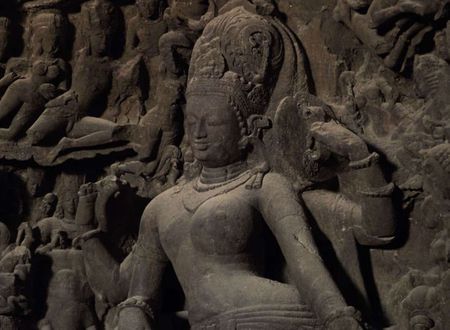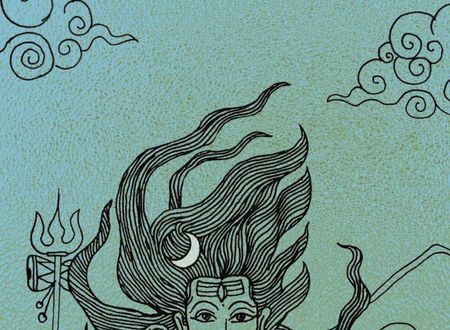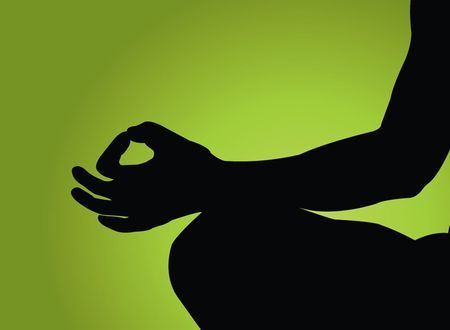What are the types of chanting?
There are four types of chanting (japa):
- Vachik (spoken) – You chant mantra out loud. Beings around you can listen to this type of chant.
- Upanshu (whisper) – You chant in the form of whispering. People around you can perceive that you’re chanting but unless it’s a quiet place, it’s not easy to make sense what you’re chanting. Upanshu isn’t the same as speaking in a low volume. For speaking, we generate sound from the throat – you can put your fingers on your throat and experience the constant vibration as long as you speak. In case of upanshu, you’re whispering largely from mouth and thus hardly experience any sound vibration in throat.
- Mansik (mental) – You chant entirely within the mind – no lip movement, no tongue movement. No one around you can tell whether you’re chanting let alone what you’re chanting. In short, mental chanting is recalling the sound of the mantra and listening to every letter, every word, with complete attention.
We’ll go through in-depth of mansik japa in this writeup based on my experience experimenting with it for years. - Ajapa (unspoken / transcendental) – You don’t’ chant – chanting happens to you. In ajapa, part of your consciousness chants the mantra and you can listen to it. From The Ancient Science of Mantras:
In unspoken chanting (ajapa), you find yourself mentally chanting all the time, the sonic energy of the mantra continues to accumulate in you. You are able to continue your chanting even when you are operating normally throughout the day doing other chores. As soon as you get up in the morning, you realize that you are already chanting your mantra.
Which type of chanting to do during sadhana?
All the four types of chanting are utilized during sadhana. Mental chanting is much more powerful than spoken chanting. Hence, it should be the preferred method.
You can start with spoken chanting for couple or so minutes and then switch to mental chanting. When you get tired with mental chanting, you can switch to either spoken or whisper chanting.
An important rule of mantra sadhana is not to reveal your mantra to anyone during sadhana. Hence, if there are people nearby, you can opt for whisper chanting instead of spoken.
As you keep doing chanting with focus and rhythm, it starts to become automatic. That’s ajapa as per my understanding and experience.
During your japa session, even if ajapa starts happening with you, it doesn’t mean that you can get relaxed and lose your mind to other thoughts. Just keep your focus on the japa happening inside by listening to it with complete attention. Alertness and mindfulness are two important guards you should employ throughout the japa to ensure quality.
How to do mental chanting (mansik japa)?
Mental chanting isn’t to speak mantra inside, rather, it’s recalling the mantra just like you recall anything else. For instance, if I ask you to recall the first line of a song of Kishor Kumar (or any other singer you know), the process you’d go through is recalling.
Similarly, in mental chanting, you recall sound of the mantra and listen to it internally, every word, every letter with complete attention.
The voice of the sound could be of your voice, or, you can hear Swamiji or anyone else first a few times, and recall the mantra in that voice.
IN the beginning, start slowly with a bigger gap between words. This is crucial because your mind is restless during initial few minutes – just like a horse, it doesn’t want you to ride it. You need to be slow and gentle with complete focus and mindfulness.
Let’s say the mantra you’re chanting is ‘om namah shivaya’. First, recall the sound of ‘om’. If you have full attention, you’ll observe it completely including both ‘o’ and ‘m’. If you can’t, increase the length of the sound of ‘om’. You’re not in a rush; you want to fix your mind attention on the sound. Also, there’s no gap between ‘o’ and ‘m’; it’s contiguous. just that each of these sounds is lengthened so you can listen to it attentively.
Next, give a second or two of pause and recall the sound of the next word ‘namah’, following the same procedure of complete attention, listening to both ‘na’ and ‘mah’.
Pause again, and follow the same for the last word ‘shivaya’. You’re able to hear ‘shi’, ‘va’ and ‘ya’.
It’s important to keep the same pace for all the words that is, if you lengthened ‘om’, similarly, lengthen both ‘namah’ and ‘shivaya’.
Similarly, whatever length you choose for the first pause (gap), keep it the same for the subsequent pauses between segments (in this case two pauses between three words of ‘om namah shivaya’).
If you don’t keep the consistency in length, you break the chhanda (meter) of the mantra and deviate from the lineage through which you got the mantra. Awakening of the mantra then becomes difficult. However, you aren’t required to lengthen both sounds and pauses at the same time (though you can do if you wish to). It doesn’t break the chhanda as I understand it.
Once you’ve done a few chants of the mantra with the same pace, and you’re able to attentively hear every letter, you’re naturally able to shorten the length of both sounds and gaps thereby increasing the pace of the chant.
You’ll experience a great control and concentration. This will continue for some time after which you may start experiencing either restlessness or exhaustion. In any case you need to slow down again. You can also stop chanting and relax for some time (30 seconds/1 minute).
If you don’t want to stop, there’s another way. Shift the position of where you’re chanting.
How to chant on chakras or different parts of your body?
Mansik japa can be done on chakras or any other part of the body you want.
You first put your awareness at the position where you want to chant the mantra, and then perform the same process of mental chanting (recalling the sound and listening to every letter).
For instance, if you want to chant at the navel area, first move your awareness at that position and just experience for a moment anything (sensation/etc.) that you observe in that area. Just keep your awareness there and do your chanting.
You can do chanting of any mantra on any chakra you want to energize. If you experience sensations during your meditation/chanting, you can eventually experience similar on the chakra/body part you start chanting regularly and diligently.
If you want to do inner worship (antaryog), you can chant any mantra on any chakra. Any beejakshara (seed syllable) can be chanted on any chakra of the body. (Devi Bhagavatam around 11:18 mark, my translation)
It’s possible (and I regularly do it) to chant one mantra on multiple chakras. For instance, ‘om’ on Muladhara, ‘namah’ on Manipura and ‘shivaya’ on Ajna (Agya) chakras in one chant.
You can also chant the whole mantra on each chakra, starting from bottom (Muladhara) through top (Sahasrara). Or, simply chant individual segments of the mantra from bottom to top (which may mean more than one chant to complete one sequence of the 7 chakras).
Initially, you can start chanting by having your awareness on your brow chakra or forehead. Once you feel some stiffness here, you can switch to chanting on multiple chakras as mentioned above.
I’ve also discovered that chanting on top of one’s head (at Sahasrara chakra) gives a deep absorption. Chanting at this place also makes you super-aware during the chant such that you’re able to hear voices/conversations happening in different rooms. Without getting into analysis of such voices, just remain focused on your chanting.
Chanting at the three knots (Muladhara-Manipura-Agya chakras), back of your head or spine helps you feel good alignment in your posture especially on days when you don’t feel the same.
I’m no longer able to hear the sound?
If you’re in deep absorption with crystal clear awareness, the auditory aspect of the sound lessens and its visual aspect becomes more prominent (more about it in the next part).
If that’s not the case here, you need to change the pitch of the sound. many a times, recalling mantra in lower pitch (like that of Swamiji’s in Sadhana App) is super audible with clarity.
The more vibrating the sound I recall, the better focus I’m able to achieve in my experience.
Sometimes, we’re either unable to recall the sound in low pitch or not able to experience deep absorption with it. In such case, you can switch to higher pitch.
Lower pitch voice is especially suitable when you want to chant on lower chakras like Muladhara/Manipura etc. In Nav Durga Sadhana of April 2022, during yajnas Swamiji made us perform chanting on different chakras while offering ahutis. the pitch of His voice got increasingly lowered (and vibrating) every time he moved to the next lower chakra in the sequence.
Just like you can refresh your attention on the chanting by changing the position of awareness (to different chakras, for example), you can similarly change pitch of the sound between low and high to achieve the same. These are subtle techniques to keep chanting with complete attention. It does require to be alert and mindful to detect dullness or restless and apply one of the techniques to refresh your attention.
When no technique seems to be working, you may opt for a short break and let your mind be relaxed.
Next Part
In the next part(s), we’ll go through things including:
- How to visualize mantra during chanting?
- How to tackle onslaught of stray thoughts or restlessness?
- How to tackle dullness/sleep?
- How to visualize divine to make your chanting 100 times effective?
Sriman Narayan
Featured image attribution: FreeSvg









Comments & Discussion
21 COMMENTS
Please login to read members' comments and participate in the discussion.